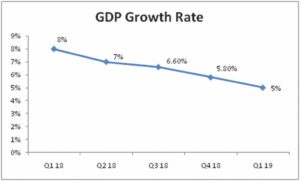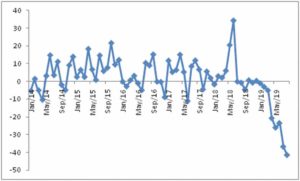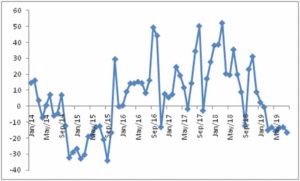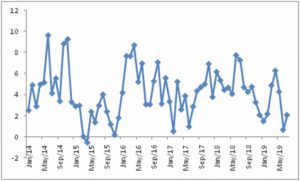Learning from History-A Risk Management Perspective
Introduction
Though risk management and its application in the corporate world are new, its essence is very old. One must remember that risk is always about the future and future is always unknown. There is a no idea what will unfold in future, however, some idea about the future can be assessed based on past data, present information and judicious judgment about the future. In the life insurance business which is about long term assessment of risk is based on similar methodologies. The life insurance businesses have been successful throughout the world based on actuarial principles.
To address any risk, it is very important to first identify the risk, assess its likely impact and plan for preventative action now, to minimize the impact of the risk, should risk materializes. Risk assessment requires a mindset with vision to anticipate future based on certain key risk indicators of present which always emanate important information about the expected future.
In the very recent past we witnessed economic slowdown resulting from reduced economic activities, the key question that is addressed in this article is, could this have been anticipated to address the economic risks to take mitigating actions earlier than later.
Glimpse to Recent Past
The Gross Domestic Product fell to 5% in the Q1 FY 2019-20 corresponding to the same period of previous year; obviously its parameters such as private consumption, investment, government expenditure and net exports performed adversely. The consequence of the slowdown was seen by job losses in different sectors of the economy, reduced earning impacting business adversely etc
The key question is, does this happened all of sudden or certain trends were available which was overlooked? Let’s see some trends in the key economic indicators in the next section.
Historic Data Indicators
Let’s look at first at a high level, how does the GDP was performing over last one year in the below graph
 It is evident that the GDP declined over the last four quarters and the performance in Q1 FY 2019-20 is not all of sudden, some initial indications were available in the second quarter of FY 2018-19.
Let’s now analyze some components of GDP over last couple of year to look at the underlying factors. Under the consumer economy, look at the year on year growth on sales in passenger vehicle from January 2014 to August 2019:
It is evident that the GDP declined over the last four quarters and the performance in Q1 FY 2019-20 is not all of sudden, some initial indications were available in the second quarter of FY 2018-19.
Let’s now analyze some components of GDP over last couple of year to look at the underlying factors. Under the consumer economy, look at the year on year growth on sales in passenger vehicle from January 2014 to August 2019:
 The early sign of volatile sales were visible way back in mid of 2017 ending with sustained negative growth from July 2018.
In the same category of consumer economy, the year on year growth in tractor sales is shown in the graph below:
The early sign of volatile sales were visible way back in mid of 2017 ending with sustained negative growth from July 2018.
In the same category of consumer economy, the year on year growth in tractor sales is shown in the graph below:
 In this category as well, early signs of volatility was recognized in 2017 followed by sustained negative growth from January 2019.
Under the industrial sector, let us look at the core infrastructure sector comprising electricity, steel, refinery products, steel, crude oil, coal, cement, natural gas and fertilizers. The graph below shows the year on year growth in the index of these eight core sectors
In this category as well, early signs of volatility was recognized in 2017 followed by sustained negative growth from January 2019.
Under the industrial sector, let us look at the core infrastructure sector comprising electricity, steel, refinery products, steel, crude oil, coal, cement, natural gas and fertilizers. The graph below shows the year on year growth in the index of these eight core sectors
 There are two downward sloping trends here, one is from May’16 to March’17 and second is from May’18 to September’18 till August’19
The above indicators indicate that some early symptoms of economic downturn were visible in the economy much before Q1 FY’20. Any such sustained downturn is a risk to the economic growth. Early signs of adverse symptoms are like an indication of early poor health requiring immediate action; the delay in taking remedial action is like allowing the disease to settle down in the body.
If we use the concepts of risk management, then keeping an eye on the future is very important. As an example, in many of the core economic sectors there were early signs of volatility were present way back in 2017. Now assuming we are in 2017 and there are volatile monthly annual growths in key sectors, then the risk mitigation plan should be prepared in 2017 and use the time between 2017 to 2019 in the implementation of those prepared action plan.
The observations of key economic indicators are very important for the corporate as they are the key sources of risks which adversely harm the business output. It is just not enough to monitor the internal Company specific risks as economic risks can give bigger and longer shocks.
Apart from the economic indicators, the new emerging risk is change in the climate showing its impact through excessive rain in different parts of the country. It may be noted that the excessive rain trend started few years back and its frequency and spread in different part of the Country is increasing ever since. This is not a good sign for both country and business together as we may get caught in a deep trouble in next couple of years when the impact of climate change is more sever.
Recently, we saw spike in crude oil following drone attack in Saudi Arabia’s oil well shooting the oil prices in India; it was a good indicator of likely rise in the inflation and subsequent ability of Central Bank to further reduce the policy rate further. Any sustained oil crises could have adverse impact on economy and business model. The good sign is the oil crisis is over; however, this parameter may be tracked for future reference.
Recently International Monetary Fund has warned about the global economic slowdown, this parameter should be tracked as our economy is no more insulated to the external world. Any international slowdown will impact the export, flow of foreign fund to India for investment, fall in the stock market etc. This may in turn further slowdown Indian business impacting both top and bottom line. The time is now ripe to monitor this global indicator to take remedial action on business now. This remedial action could be change in the product design, change in the target market, cost rationalization and change in the business model to cater the emerging need if global slowdown impact Indian market.
Tracking the Indicators
Continue tracking of risk indicators be it economic or Company specific is very important for the success of the Company. This helps in nipping the risk at its bud; there is a no point in waiting for the indicators to get red. There is also a need to add more indicators such as risks emanating from demographic factors, environmental factors, factors that have never been tracked but may cause entire disruption of the business such as failure of internet. If internet fails, many businesses depending on online will collapse.
Environmental risk is the most dangerous risks that may wipe out entire economic progress if remedial actions are not taken now. The time has come to track the environmental risk in businesses. Excessive rain during 2019 in different parts of the country breaking records of 100s of years is a warning signal. This warning signal is akin to or more severe than economic indicators that were missed in the distant past.
It is important to identify the right indicators representing the risks, sometimes some decisions lead to impact which come out in a form of indicator much later on the time scale. For example, no one anticipated the impact on the economy of the demonetization decision taken way back in 2016. It took around three and a half years to begin its impact visible. This is where a judicious judgment is important using information available ‘at present” along with the historic data. If there were proper mechanism of risk management in business houses were there along with tracking of economic indicators, these three and a half years would have used in taking mitigating action.
There are economic generator models are available that can be used for the purpose of anticipating the future along with judgment. Along with the economic generator models, predictive models can also be used for projecting the future. The need is to develop futuristic thinking and “what if” mindset. The developed economy has instituted corporate governance guidelines based on their adverse experiences in the past. The key question is can we avoid something like 2008 crisis in India?
Someone may argue that it is easy to comment in the hindsight on the risks that materialized. That is the message to learn from the history and prepare for the future and start taking the mitigating action now from emerging risks indicators. No event in the world happen all of sudden and some information is always available giving hint about the future. If we wish to minimize the adverse impact of the risks, the time is now.
Quantification of Risks
It is very important to quantify the risk on the scale of likelihood and impact as this helps in identifying the top risk requiring more urgent attention. If sales of passenger car are showing more negative growth compared to two wheeler sales, then immediate action is required to boost passenger vehicle.
There are at times some risks are low in likelihood and very high in impact; for example failure of internet has low likelihood but its impact could be devastating. The treatment of this risk will be different compared to risk of falling sales in passenger vehicle.
Conclusion
Risks does not occur in isolation and suddenly, it always give early warning signals; it could be a different matter that we have not developed and implemented robust risk management framework for its mitigation. The key to future risk mitigation is to keep all eyes and ears open and act early, time may be short in future to address risks.
Authored By:
There are two downward sloping trends here, one is from May’16 to March’17 and second is from May’18 to September’18 till August’19
The above indicators indicate that some early symptoms of economic downturn were visible in the economy much before Q1 FY’20. Any such sustained downturn is a risk to the economic growth. Early signs of adverse symptoms are like an indication of early poor health requiring immediate action; the delay in taking remedial action is like allowing the disease to settle down in the body.
If we use the concepts of risk management, then keeping an eye on the future is very important. As an example, in many of the core economic sectors there were early signs of volatility were present way back in 2017. Now assuming we are in 2017 and there are volatile monthly annual growths in key sectors, then the risk mitigation plan should be prepared in 2017 and use the time between 2017 to 2019 in the implementation of those prepared action plan.
The observations of key economic indicators are very important for the corporate as they are the key sources of risks which adversely harm the business output. It is just not enough to monitor the internal Company specific risks as economic risks can give bigger and longer shocks.
Apart from the economic indicators, the new emerging risk is change in the climate showing its impact through excessive rain in different parts of the country. It may be noted that the excessive rain trend started few years back and its frequency and spread in different part of the Country is increasing ever since. This is not a good sign for both country and business together as we may get caught in a deep trouble in next couple of years when the impact of climate change is more sever.
Recently, we saw spike in crude oil following drone attack in Saudi Arabia’s oil well shooting the oil prices in India; it was a good indicator of likely rise in the inflation and subsequent ability of Central Bank to further reduce the policy rate further. Any sustained oil crises could have adverse impact on economy and business model. The good sign is the oil crisis is over; however, this parameter may be tracked for future reference.
Recently International Monetary Fund has warned about the global economic slowdown, this parameter should be tracked as our economy is no more insulated to the external world. Any international slowdown will impact the export, flow of foreign fund to India for investment, fall in the stock market etc. This may in turn further slowdown Indian business impacting both top and bottom line. The time is now ripe to monitor this global indicator to take remedial action on business now. This remedial action could be change in the product design, change in the target market, cost rationalization and change in the business model to cater the emerging need if global slowdown impact Indian market.
Tracking the Indicators
Continue tracking of risk indicators be it economic or Company specific is very important for the success of the Company. This helps in nipping the risk at its bud; there is a no point in waiting for the indicators to get red. There is also a need to add more indicators such as risks emanating from demographic factors, environmental factors, factors that have never been tracked but may cause entire disruption of the business such as failure of internet. If internet fails, many businesses depending on online will collapse.
Environmental risk is the most dangerous risks that may wipe out entire economic progress if remedial actions are not taken now. The time has come to track the environmental risk in businesses. Excessive rain during 2019 in different parts of the country breaking records of 100s of years is a warning signal. This warning signal is akin to or more severe than economic indicators that were missed in the distant past.
It is important to identify the right indicators representing the risks, sometimes some decisions lead to impact which come out in a form of indicator much later on the time scale. For example, no one anticipated the impact on the economy of the demonetization decision taken way back in 2016. It took around three and a half years to begin its impact visible. This is where a judicious judgment is important using information available ‘at present” along with the historic data. If there were proper mechanism of risk management in business houses were there along with tracking of economic indicators, these three and a half years would have used in taking mitigating action.
There are economic generator models are available that can be used for the purpose of anticipating the future along with judgment. Along with the economic generator models, predictive models can also be used for projecting the future. The need is to develop futuristic thinking and “what if” mindset. The developed economy has instituted corporate governance guidelines based on their adverse experiences in the past. The key question is can we avoid something like 2008 crisis in India?
Someone may argue that it is easy to comment in the hindsight on the risks that materialized. That is the message to learn from the history and prepare for the future and start taking the mitigating action now from emerging risks indicators. No event in the world happen all of sudden and some information is always available giving hint about the future. If we wish to minimize the adverse impact of the risks, the time is now.
Quantification of Risks
It is very important to quantify the risk on the scale of likelihood and impact as this helps in identifying the top risk requiring more urgent attention. If sales of passenger car are showing more negative growth compared to two wheeler sales, then immediate action is required to boost passenger vehicle.
There are at times some risks are low in likelihood and very high in impact; for example failure of internet has low likelihood but its impact could be devastating. The treatment of this risk will be different compared to risk of falling sales in passenger vehicle.
Conclusion
Risks does not occur in isolation and suddenly, it always give early warning signals; it could be a different matter that we have not developed and implemented robust risk management framework for its mitigation. The key to future risk mitigation is to keep all eyes and ears open and act early, time may be short in future to address risks.
Authored By:
 Sonjai Kumar
Certified Risk Management Professional from IRM London
Sonjai Kumar
Certified Risk Management Professional from IRM London
 It is evident that the GDP declined over the last four quarters and the performance in Q1 FY 2019-20 is not all of sudden, some initial indications were available in the second quarter of FY 2018-19.
Let’s now analyze some components of GDP over last couple of year to look at the underlying factors. Under the consumer economy, look at the year on year growth on sales in passenger vehicle from January 2014 to August 2019:
It is evident that the GDP declined over the last four quarters and the performance in Q1 FY 2019-20 is not all of sudden, some initial indications were available in the second quarter of FY 2018-19.
Let’s now analyze some components of GDP over last couple of year to look at the underlying factors. Under the consumer economy, look at the year on year growth on sales in passenger vehicle from January 2014 to August 2019:
 The early sign of volatile sales were visible way back in mid of 2017 ending with sustained negative growth from July 2018.
In the same category of consumer economy, the year on year growth in tractor sales is shown in the graph below:
The early sign of volatile sales were visible way back in mid of 2017 ending with sustained negative growth from July 2018.
In the same category of consumer economy, the year on year growth in tractor sales is shown in the graph below:
 In this category as well, early signs of volatility was recognized in 2017 followed by sustained negative growth from January 2019.
Under the industrial sector, let us look at the core infrastructure sector comprising electricity, steel, refinery products, steel, crude oil, coal, cement, natural gas and fertilizers. The graph below shows the year on year growth in the index of these eight core sectors
In this category as well, early signs of volatility was recognized in 2017 followed by sustained negative growth from January 2019.
Under the industrial sector, let us look at the core infrastructure sector comprising electricity, steel, refinery products, steel, crude oil, coal, cement, natural gas and fertilizers. The graph below shows the year on year growth in the index of these eight core sectors
 There are two downward sloping trends here, one is from May’16 to March’17 and second is from May’18 to September’18 till August’19
The above indicators indicate that some early symptoms of economic downturn were visible in the economy much before Q1 FY’20. Any such sustained downturn is a risk to the economic growth. Early signs of adverse symptoms are like an indication of early poor health requiring immediate action; the delay in taking remedial action is like allowing the disease to settle down in the body.
If we use the concepts of risk management, then keeping an eye on the future is very important. As an example, in many of the core economic sectors there were early signs of volatility were present way back in 2017. Now assuming we are in 2017 and there are volatile monthly annual growths in key sectors, then the risk mitigation plan should be prepared in 2017 and use the time between 2017 to 2019 in the implementation of those prepared action plan.
The observations of key economic indicators are very important for the corporate as they are the key sources of risks which adversely harm the business output. It is just not enough to monitor the internal Company specific risks as economic risks can give bigger and longer shocks.
Apart from the economic indicators, the new emerging risk is change in the climate showing its impact through excessive rain in different parts of the country. It may be noted that the excessive rain trend started few years back and its frequency and spread in different part of the Country is increasing ever since. This is not a good sign for both country and business together as we may get caught in a deep trouble in next couple of years when the impact of climate change is more sever.
Recently, we saw spike in crude oil following drone attack in Saudi Arabia’s oil well shooting the oil prices in India; it was a good indicator of likely rise in the inflation and subsequent ability of Central Bank to further reduce the policy rate further. Any sustained oil crises could have adverse impact on economy and business model. The good sign is the oil crisis is over; however, this parameter may be tracked for future reference.
Recently International Monetary Fund has warned about the global economic slowdown, this parameter should be tracked as our economy is no more insulated to the external world. Any international slowdown will impact the export, flow of foreign fund to India for investment, fall in the stock market etc. This may in turn further slowdown Indian business impacting both top and bottom line. The time is now ripe to monitor this global indicator to take remedial action on business now. This remedial action could be change in the product design, change in the target market, cost rationalization and change in the business model to cater the emerging need if global slowdown impact Indian market.
Tracking the Indicators
Continue tracking of risk indicators be it economic or Company specific is very important for the success of the Company. This helps in nipping the risk at its bud; there is a no point in waiting for the indicators to get red. There is also a need to add more indicators such as risks emanating from demographic factors, environmental factors, factors that have never been tracked but may cause entire disruption of the business such as failure of internet. If internet fails, many businesses depending on online will collapse.
Environmental risk is the most dangerous risks that may wipe out entire economic progress if remedial actions are not taken now. The time has come to track the environmental risk in businesses. Excessive rain during 2019 in different parts of the country breaking records of 100s of years is a warning signal. This warning signal is akin to or more severe than economic indicators that were missed in the distant past.
It is important to identify the right indicators representing the risks, sometimes some decisions lead to impact which come out in a form of indicator much later on the time scale. For example, no one anticipated the impact on the economy of the demonetization decision taken way back in 2016. It took around three and a half years to begin its impact visible. This is where a judicious judgment is important using information available ‘at present” along with the historic data. If there were proper mechanism of risk management in business houses were there along with tracking of economic indicators, these three and a half years would have used in taking mitigating action.
There are economic generator models are available that can be used for the purpose of anticipating the future along with judgment. Along with the economic generator models, predictive models can also be used for projecting the future. The need is to develop futuristic thinking and “what if” mindset. The developed economy has instituted corporate governance guidelines based on their adverse experiences in the past. The key question is can we avoid something like 2008 crisis in India?
Someone may argue that it is easy to comment in the hindsight on the risks that materialized. That is the message to learn from the history and prepare for the future and start taking the mitigating action now from emerging risks indicators. No event in the world happen all of sudden and some information is always available giving hint about the future. If we wish to minimize the adverse impact of the risks, the time is now.
Quantification of Risks
It is very important to quantify the risk on the scale of likelihood and impact as this helps in identifying the top risk requiring more urgent attention. If sales of passenger car are showing more negative growth compared to two wheeler sales, then immediate action is required to boost passenger vehicle.
There are at times some risks are low in likelihood and very high in impact; for example failure of internet has low likelihood but its impact could be devastating. The treatment of this risk will be different compared to risk of falling sales in passenger vehicle.
Conclusion
Risks does not occur in isolation and suddenly, it always give early warning signals; it could be a different matter that we have not developed and implemented robust risk management framework for its mitigation. The key to future risk mitigation is to keep all eyes and ears open and act early, time may be short in future to address risks.
Authored By:
There are two downward sloping trends here, one is from May’16 to March’17 and second is from May’18 to September’18 till August’19
The above indicators indicate that some early symptoms of economic downturn were visible in the economy much before Q1 FY’20. Any such sustained downturn is a risk to the economic growth. Early signs of adverse symptoms are like an indication of early poor health requiring immediate action; the delay in taking remedial action is like allowing the disease to settle down in the body.
If we use the concepts of risk management, then keeping an eye on the future is very important. As an example, in many of the core economic sectors there were early signs of volatility were present way back in 2017. Now assuming we are in 2017 and there are volatile monthly annual growths in key sectors, then the risk mitigation plan should be prepared in 2017 and use the time between 2017 to 2019 in the implementation of those prepared action plan.
The observations of key economic indicators are very important for the corporate as they are the key sources of risks which adversely harm the business output. It is just not enough to monitor the internal Company specific risks as economic risks can give bigger and longer shocks.
Apart from the economic indicators, the new emerging risk is change in the climate showing its impact through excessive rain in different parts of the country. It may be noted that the excessive rain trend started few years back and its frequency and spread in different part of the Country is increasing ever since. This is not a good sign for both country and business together as we may get caught in a deep trouble in next couple of years when the impact of climate change is more sever.
Recently, we saw spike in crude oil following drone attack in Saudi Arabia’s oil well shooting the oil prices in India; it was a good indicator of likely rise in the inflation and subsequent ability of Central Bank to further reduce the policy rate further. Any sustained oil crises could have adverse impact on economy and business model. The good sign is the oil crisis is over; however, this parameter may be tracked for future reference.
Recently International Monetary Fund has warned about the global economic slowdown, this parameter should be tracked as our economy is no more insulated to the external world. Any international slowdown will impact the export, flow of foreign fund to India for investment, fall in the stock market etc. This may in turn further slowdown Indian business impacting both top and bottom line. The time is now ripe to monitor this global indicator to take remedial action on business now. This remedial action could be change in the product design, change in the target market, cost rationalization and change in the business model to cater the emerging need if global slowdown impact Indian market.
Tracking the Indicators
Continue tracking of risk indicators be it economic or Company specific is very important for the success of the Company. This helps in nipping the risk at its bud; there is a no point in waiting for the indicators to get red. There is also a need to add more indicators such as risks emanating from demographic factors, environmental factors, factors that have never been tracked but may cause entire disruption of the business such as failure of internet. If internet fails, many businesses depending on online will collapse.
Environmental risk is the most dangerous risks that may wipe out entire economic progress if remedial actions are not taken now. The time has come to track the environmental risk in businesses. Excessive rain during 2019 in different parts of the country breaking records of 100s of years is a warning signal. This warning signal is akin to or more severe than economic indicators that were missed in the distant past.
It is important to identify the right indicators representing the risks, sometimes some decisions lead to impact which come out in a form of indicator much later on the time scale. For example, no one anticipated the impact on the economy of the demonetization decision taken way back in 2016. It took around three and a half years to begin its impact visible. This is where a judicious judgment is important using information available ‘at present” along with the historic data. If there were proper mechanism of risk management in business houses were there along with tracking of economic indicators, these three and a half years would have used in taking mitigating action.
There are economic generator models are available that can be used for the purpose of anticipating the future along with judgment. Along with the economic generator models, predictive models can also be used for projecting the future. The need is to develop futuristic thinking and “what if” mindset. The developed economy has instituted corporate governance guidelines based on their adverse experiences in the past. The key question is can we avoid something like 2008 crisis in India?
Someone may argue that it is easy to comment in the hindsight on the risks that materialized. That is the message to learn from the history and prepare for the future and start taking the mitigating action now from emerging risks indicators. No event in the world happen all of sudden and some information is always available giving hint about the future. If we wish to minimize the adverse impact of the risks, the time is now.
Quantification of Risks
It is very important to quantify the risk on the scale of likelihood and impact as this helps in identifying the top risk requiring more urgent attention. If sales of passenger car are showing more negative growth compared to two wheeler sales, then immediate action is required to boost passenger vehicle.
There are at times some risks are low in likelihood and very high in impact; for example failure of internet has low likelihood but its impact could be devastating. The treatment of this risk will be different compared to risk of falling sales in passenger vehicle.
Conclusion
Risks does not occur in isolation and suddenly, it always give early warning signals; it could be a different matter that we have not developed and implemented robust risk management framework for its mitigation. The key to future risk mitigation is to keep all eyes and ears open and act early, time may be short in future to address risks.
Authored By:
 Sonjai Kumar
Certified Risk Management Professional from IRM London
Sonjai Kumar
Certified Risk Management Professional from IRM London 



Leave a Reply